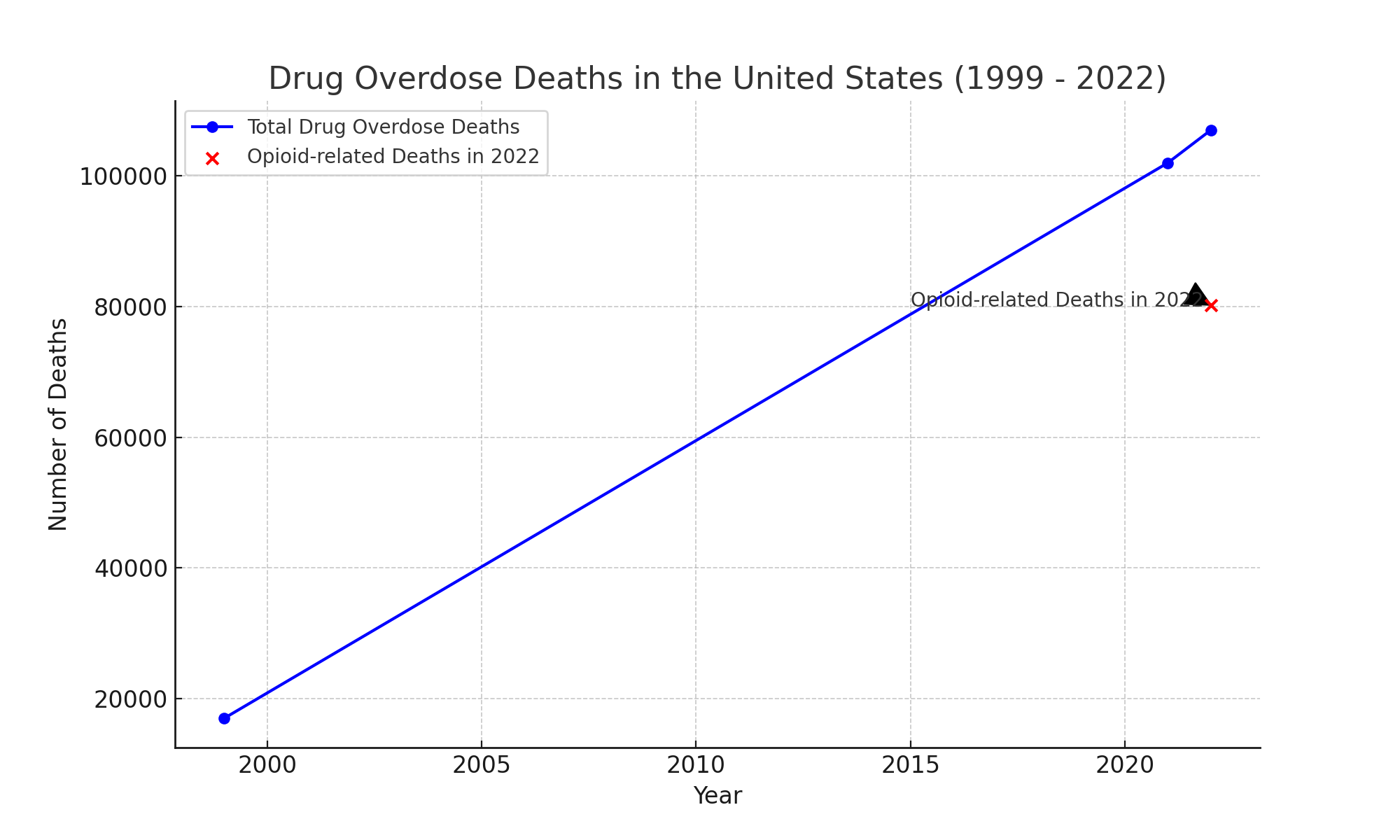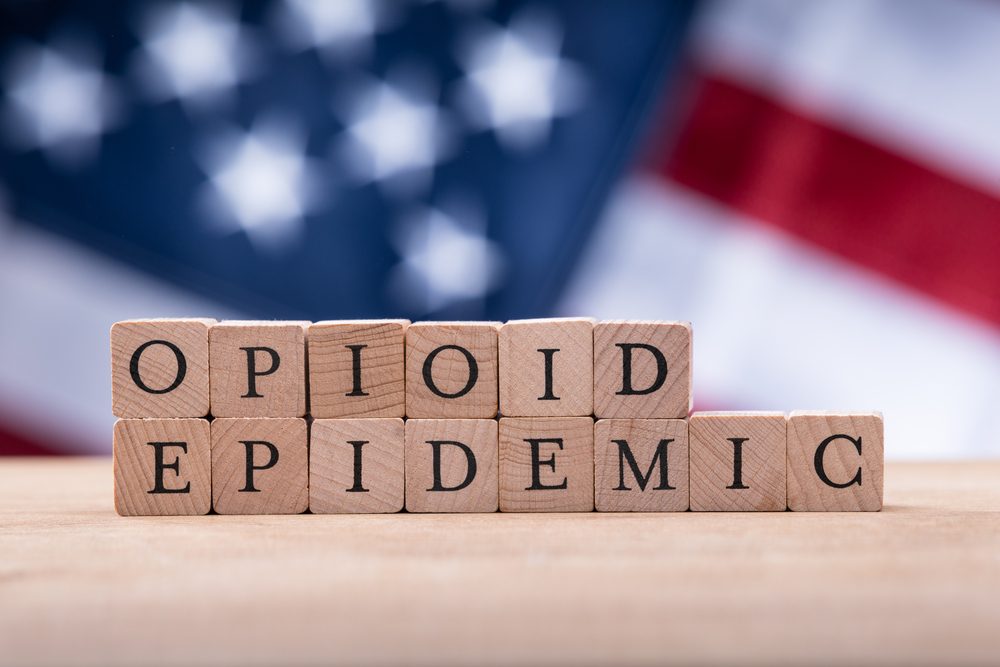The opioid epidemic has undoubtedly posed significant challenges across the United States, impacting countless lives and communities. However, amidst the adversity, a growing wave of awareness, understanding, and proactive measures are being taken to address this complex issue. It’s a public health crisis that demands our attention, but it’s also a testament to the resilience of the human spirit and the power of collective action.
In recent years, the statistics surrounding opioid overdose deaths have revealed the true extent of the crisis. While these figures serve as a stark reminder of the challenges ahead, they have sparked a nationwide effort to confront the crisis head-on. The Centers for Disease Control and Prevention (CDC) reports that over 70,000 Americans died from drug overdoses in 2021, with the majority involving opioids.¹ These numbers, while sobering, are a call to action, prompting a surge in research, education, and innovative treatment approaches.
In this blog post, we’ll explore the opioid epidemic from all angles: its history, causes, and wide-ranging effects. We’ll also highlight effective treatment options and prevention strategies that are helping individuals and communities recover. Whether you’re seeking a deeper understanding of the crisis, information on treatment, or want to learn about current efforts to address it, this post is for you.

Graph showing the increase in drug overdose death rates in the United States from 1999 to 2022, majority are opioid involved overdose deaths.
Historical Context
The roots of the opioid epidemic run deep, tracing back to the early medical applications of opium and its derivatives. For centuries, opioids have been used to alleviate pain, with morphine and codeine emerging as widely prescribed painkillers in the 19th century. However, it wasn’t until the late 20th century that the seeds of the current crisis were indeed sown.
In the 1990s, pharmaceutical companies began aggressively marketing prescription opioids, such as OxyContin, as safe and effective for managing chronic pain. They downplayed the risks of addiction and overstated the benefits, leading to a surge in opioid prescriptions.² This marked a significant shift in pain management practices, as opioids were increasingly prescribed for non-cancer-related pain, expanding their use beyond the traditional realm of palliative care.
Driven by misleading marketing campaigns and a lack of awareness about the addictive potential of these drugs, healthcare providers began overprescribing opioids at alarming rates. This widespread availability and normalization of opioid use paved the way for misuse, abuse, and addiction. As more individuals became dependent on prescription opioids, a thriving black market emerged, further fueling the crisis.
Understanding Opioids
Opioids are a class of drugs derived from the opium poppy plant or synthesized in laboratories. They interact with opioid receptors in the brain, spinal cord, and other organs to produce pain relief, sedation, and a sense of euphoria.³ While opioids can be effective for managing acute pain, their prolonged use can lead to tolerance, dependence, and addiction.
There are three main categories of opioids:
- Natural Opioids: These are derived directly from the opium poppy plant and include morphine and codeine.
- Semi-Synthetic Opioids: These are created by modifying natural opioids and include heroin, oxycodone (OxyContin), and hydrocodone (Vicodin).
- Synthetic Opioids: These are entirely lab-made and include fentanyl, methadone, and tramadol.
Opioid addiction develops as the brain adapts to the repeated presence of these drugs. Over time, the brain becomes less responsive to the effects of opioids, requiring higher doses to achieve the same level of pain relief or euphoria. This tolerance can quickly escalate into dependence, where the body and brain rely on opioids to function normally. Withdrawal symptoms, such as intense cravings, muscle aches, nausea, and anxiety, can occur when opioid use is stopped abruptly.
Fentanyl, a synthetic opioid up to 100 times more potent than morphine, poses a particularly grave danger.4 Its illicit production and distribution have contributed to a surge in overdose deaths, as it is often mixed with other drugs or sold as counterfeit pills. The potency of fentanyl makes it highly addictive and significantly increases the risk of overdose.
Causes of the Opioid Epidemic
The opioid epidemic is not a single-issue crisis; it stems from a complex interplay of factors, including:
- Physical Pain: The widespread use of opioids for pain management, particularly for chronic pain conditions, has played a significant role in the epidemic. While opioids can offer relief, they also carry a high risk of dependence, especially when used long-term.5
- Mental Health Conditions: Co-occurring mental health disorders, such as depression, anxiety, and post-traumatic stress disorder (PTSD), are strongly associated with opioid addiction. Individuals with mental health conditions may turn to opioids to self-medicate or cope with emotional distress, increasing their vulnerability to addiction.6
- Social Determinants of Health: Socioeconomic factors, such as poverty, lack of access to healthcare, and exposure to trauma, can significantly increase the risk of opioid addiction. These factors create a breeding ground for despair and hopelessness, making individuals more susceptible to substance abuse as a means of escape.7
- Marketing and Overprescription: Aggressive marketing tactics by pharmaceutical companies, coupled with lax prescribing practices by healthcare providers, fueled the initial surge in opioid use and addiction. Misleading information about the safety and effectiveness of these drugs led to their widespread use, often for conditions not warranting opioid therapy.1

Consequences of the Opioid Crisis
The opioid crisis has unleashed a cascade of devastating consequences that extend far beyond the individual struggling with addiction. Its ripple effects touch families, communities, and society as a whole, leaving a trail of pain, loss, and economic burden.
- Physical Health Consequences: The most immediate and visible consequence is the alarming rise in overdose deaths. Opioids, particularly fentanyl, have become the leading cause of overdose fatalities in the United States.8 Beyond opioid overdoses, opioid use can lead to a host of other physical health problems, including infections, cardiovascular issues, respiratory depression, and organ damage.9
- Mental Health Consequences: Opioid addiction often co-occurs with mental health disorders, such as depression, anxiety, and PTSD. The chronic stress of addiction can exacerbate these conditions, leading to a downward spiral of emotional and psychological distress. Individuals with opioid use disorder are also at a higher risk of suicide.10
- Social Consequences: The impact of opioid addiction extends to families and communities. Strained relationships, job loss, financial instability, and social isolation are common consequences. Children of parents with opioid use disorder are particularly vulnerable, facing increased risks of neglect, abuse, and developmental problems. The epidemic has also fueled homelessness and crime rates in many communities.11
- Economic Consequences: The opioid epidemic places a significant burden on the healthcare system, with costs associated with emergency room visits, hospitalizations, addiction treatment, and overdose prevention programs. The economic impact extends to lost productivity, reduced workforce participation, and increased criminal justice expenses.12
Treatment Options
Fortunately, there are evidence-based treatment options available to help individuals overcome opioid addiction and reclaim their lives. These approaches address the physical, psychological, and social aspects of addiction, offering a holistic path to recovery.
Experiential Therapies
Experiential therapies utilize immersive experiences, such as adventure, art, equine, and wilderness therapy, to help individuals process trauma, develop coping skills, and rebuild their lives. Experiential therapies offer a unique way to engage with the healing process, fostering self-awareness, personal growth, and a sense of connection to others and the natural world.13
Behavioral Therapies
Cognitive-behavioral therapy (CBT) and other behavioral therapies help individuals identify and change negative thought patterns and behaviors that contribute to addiction. These therapies equip individuals with coping mechanisms to manage cravings, prevent relapse, and develop healthier lifestyles.14
Support Groups
Mutual aid groups, such as Narcotics Anonymous (NA), provide a safe and supportive environment for individuals in recovery. These groups offer peer support, shared experiences, and a sense of community, which are essential for long-term recovery.
Prevention Strategies for Opioid Abuse
Preventing opioid addiction and overdose requires a multi-pronged approach that addresses the root causes of the crisis and promotes safe practices. By implementing effective prevention strategies, we can reduce the number of new cases of prescription drug abuse, prevent opioid overdose deaths, and support healthier communities.
- Responsible Prescribing Practices: Healthcare providers play a crucial role in preventing opioid addiction by prescribing these medications cautiously and only when necessary. Encouraging the use of alternative pain management options, such as physical therapy, non-opioid medications, and complementary therapies, can reduce reliance on opioids and minimize the risk of dependence.15
- Public Awareness Campaigns: Educating the public about the risks of opioid addiction and the importance of safe medication practices is essential. Public awareness campaigns can raise awareness about the signs and symptoms of addiction, promote safe storage and disposal of unused medication, and reduce the stigma associated with seeking help.16
- Access to Treatment: Expanding access to evidence-based treatment options is critical for individuals struggling with opioid addiction. This includes increasing the availability of medication-assisted treatment (MAT), behavioral therapies, harm reduction services, and support groups. Removing barriers to care, such as cost and stigma, is also essential for ensuring that everyone who needs help can access it.17
By implementing these comprehensive prevention strategies, we can create a society where individuals are empowered to make informed decisions about their health, healthcare providers prioritize safe and effective pain management, and communities have the resources and support they need to address the opioid epidemic and promote recovery.

Overcoming Opioid Addiction with BIG SKY Treatment
The opioid epidemic is a complex challenge, but it’s not insurmountable. We can overcome this crisis with knowledge, education, and a comprehensive approach to prevention and treatment.
By understanding the history, nature of opioids, and root causes of addiction, we empower individuals to make informed choices and seek help. Diverse treatment options, from experiential therapies to behavioral interventions, offer hope and healing for those on the path to recovery.
If you or a loved one is struggling with opioid use disorder, BIG SKY Treatment offers a comprehensive approach to treatment, combining evidence-based therapies, individualized care, and a supportive community.
Contact BIG SKY Treatment today to learn more about our programs and take the first step towards recovery.
References:
- Centers for Disease Control and Keyes KM, Cerdá M, Brady JE, Havens JR, Galea S, 2014. Understanding the rural-urban differences in nonmedical prescription opioid use and abuse in the United States. Am. J. Public Health 104, e52–e59 Prevention (CDC). (2023). Understanding the epidemic.
https://www.cdc.gov/overdose-prevention/about/understanding-the-opioid-overdose-epidemic.html - Van Zee, A. (2009). The promotion and marketing of oxycontin: commercial triumph, public health tragedy. American Journal of Public Health, 99(2), 221-227. https://doi.org/10.2105/ajph.2007.131714
- National Institute on Drug Abuse (NIDA). (2023). Opioids. https://www.nih.gov/about-nih/what-we-do/nih-almanac/national-institute-drug-abuse-nida
- DEA. (2023, May 2). Fentanyl. https://www.dea.gov/
- Volkow, N. D., & McLellan, A. T. (2016). Opioid abuse in chronic pain—Misconceptions and mitigation strategies. New England Journal of Medicine, 374(13), 1253-1263.
https://txaf.org/neuropharmacological-effects-of-fentanyl-mcgregor/ - National Institute of Mental Health (NIMH). (2023). Opioid misuse and addiction. https://www.nimh.nih.gov/
- Keyes, K. M., Cerdá, M., Brady, J. E., Havens, J. R., & Galea, S. (2014). Understanding the rural-urban differences in nonmedical prescription opioid use and abuse in the United States. American Journal of Public Health, 104(2), e52-e59.
https://ajph.aphapublications.org/doi/full/10.2105/AJPH.2013.301709 - Wilson, N., Kariisa, M., Seth, P., Smith, H., Davis, N. L., & Rolka, H. (2020). Drug and Opioid-Involved Overdose Deaths — United States, 2017–2018. MMWR. Morbidity and Mortality Weekly Report, 69(11), 290–297.
- Volkow, N. D. (2014). America’s addiction to opioids: Heroin and prescription drug abuse. The Journal of the American Medical Association, 311(22), 2275-2276.
- Park, T. W., Saitz, R., Ganoczy, D., Ilgen, M. A., Bohnert, A. S., & McCarthy, J. F. (2016). Suicide Attempts and Suicidal Ideation Among Patients Receiving Opioid Agonist Treatment. Addiction Science & Clinical Practice, 11(1), 1-8.
- Wilder, C. M., & Roy, K. M. (2017). Associations between opioid dispensing, opioid use disorder, and crime. American Journal of Public Health, 107(2), 283–289.
- Florence, C. S., Zhou, C., Luo, F., & Xu, L. (2016). The Economic Burden of Prescription Opioid Overdose, Abuse, and Dependence in the United States, 2013. Medical Care, 54(10), 901-906.
- Pascual-Leone, A., & Greenberg, L. S. (2007). Insight and Awareness in Experiential Therapy. In L. G. Castonguay & C. Hill (Eds.), Insight in psychotherapy (pp.31–56). American Psychological Association. https://doi.org/10.1037/11532-002
- National Institute on Drug Abuse (NIDA). (2011). Drugs, Brains, and Behavior: The Science of Addiction.
https://nida.nih.gov/publications/drugs-brains-behavior-science-addiction/treatment-recovery - Dowell, D., Haegerich, T. M., & Chou, R. (2016). CDC Guideline for Prescribing Opioids for Chronic Pain — United States, 2016. MMWR. Recommendations and Reports, 65(1), 1-49.
- U.S. Department of Health and Human Services (HHS). (2023). Opioid misuse prevention. https://www.samhsa.gov/
- National Academies of Sciences, Engineering, and Medicine. (2017). Pain management and the opioid epidemic: Balancing societal and individual benefits and risks of prescription opioid use. National Academies Press. https://nap.nationalacademies.org/catalog/24781/pain-management-and-the-opioid-epidemic-balancing-societal-and-individual







